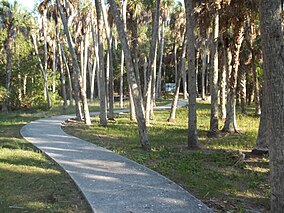Madira Bickel Mound State Archaeological Site
| Madira Bickel Mound State Archaeological Site | |
|---|---|
IUCN category V (protected landscape/seascape) | |
 Path leading to the mound | |
| Location | Manatee County, Florida, USA |
| Nearest city | Palmetto, Florida |
| Coordinates | 27°33′55″N 82°35′34″W / 27.56528°N 82.59278°W |
| Area | 10 acres (0.040 km2) |
| Established | August 12, 1970 |
| Governing body | Florida Department of Environmental Protection |
The Madira Bickel Mound State Archaeological Site is an
The 10-acre (0.040 km2) site was the first
History
Archaeological excavations have established that indigenous occupation reaches back 2,000 years, and across three distinct periods:
Scholars believe that the mound site continued to be of great ceremonial importance to the historic
The site is named for Madira Bickel of Sarasota. She and her husband, Karl, purchased the land around the main mound and donated it to the state in 1948.[1]
The mounds
The point of greatest interest at the site is the 20-foot (6.1 m) high temple/ceremonial mound. Composed of shells (obtained from a
The state park has graduated stairways for access, and at the top, has cleared an area (protected by a fence) for overlooking the park. Over the centuries, the mound has become covered with vegetation, including tall trees.
Also in the park are the remains of the Prine Burial Mound, which is circular, about 40 feet (12 m) wide, and about 2 feet (0.61 m) high at the center. It was used through the three major archaeological cultures described above, from 800-1500 AD. Since settlement and development, much of the mound's contents have been disturbed.
References
- Florida State Parks. Retrieved April 23, 2018.
External links
- Madira Bickel Mounds State Archaeological Site at Florida State Parks
- Manatee County listings, Florida's Office of Cultural and Historical Programs
- "Madira Bickel Temple Mound Site", School District of Manatee County
- Madira Bickel Mound Photograph Gallery, Florida Center for Instructional Technology, University of South Florida


